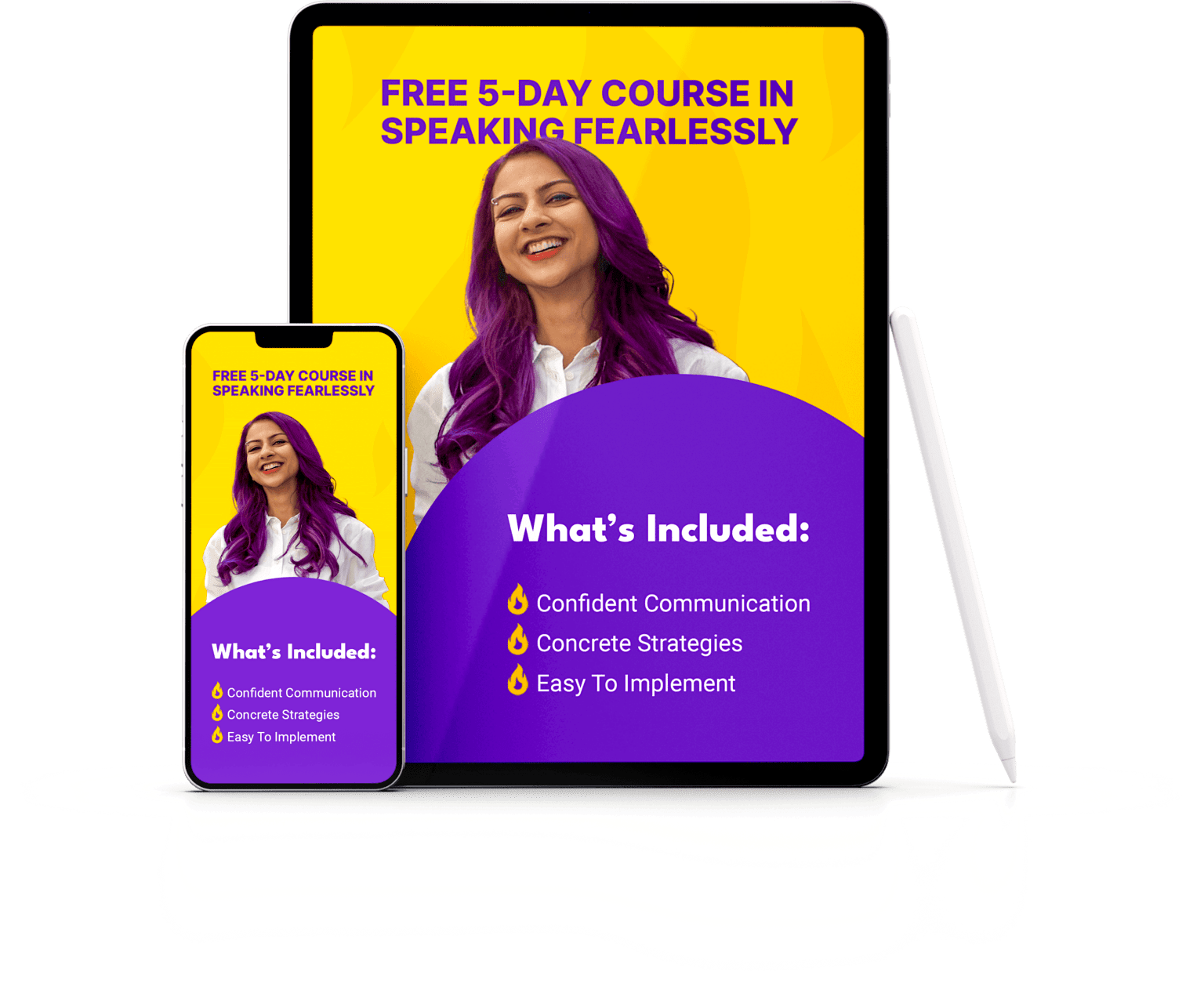Have you ever experienced shortness of breath, a racing pulse and feeling like you’re not in control before speaking to an audience?
Pre-speech anxiety is natural nervousness that nearly everyone experiences. Even seasoned speakers occasionally grapple with nerves. It is actually a sign that you care about the quality of your presentation.
But the fact remains – whether you’re facing a live stage or talking at a crucial online meeting, the pounding heartbeat, rapid breathing and shaky legs can be overwhelming.
Having spoken on stage and on camera for more than 17 years, I can say with confidence that breathing is a critical yet often overlooked tool in becoming an impactful public speaker.
Your solution is oxygen. Breathe.
In this article, you will discover five breathing techniques to quickly ease your stress and boost your confidence whenever you step onto a stage, speak online or present in the boardroom.
Table of Contents
Importance of Breathing Before You Speak in Public
People mistakenly believe that nobody needs to be taught how to breathe. Shouldn’t it come “naturally” to us all? According to the Physiological Society’s Journal, we often give in to shallow breathing when we come under duress, which:
- Raises our anxiety levels.
- Makes our heart race uncontrollably fast.
- And stops us from feeling like we’re in control.
Conscious breathing, on the other hand, helps regulate the nervous system. This mitigates anxiety, creating a more favorable mental and physiological state in public speaking situations.
By focusing on intentional and deep breathing before stepping in front of an audience, you can activate your body’s relaxation response. This is a way to counteract the nerves.
The best part is that using proper breathing techniques doesn’t just calm your nerves. It also ensures your voice comes across confidently.
Here are 5 breathing techniques that I recommend my clients to practice before an important talk. Follow these to center yourself and focus on delivering the most engaging presentation ever.
1. 4-7-8 Breathing
The 4-7-8 breathing technique, a.k.a. “relaxing breath” was conceived by Harvard-trained Dr. Andrew Weil. It’s a simple yet powerful method using controlled inhaling, holding the breath, and intentional exhaling.
This technique helps you control your breathing. You’re able to redirect the mind and body to concentrate on regulating breath rather than dwelling on anxieties. It’s a very useful strategy before stressful meetings or presentations. It helps you relax, reduces your stress and promotes a sense of calmness.
Follow the simple steps below to practice the 4-7-8 breathing technique:
- Inhale through your nose for a count of four.
- Hold your breath for a count of seven.
- Exhale completely through your mouth for a count of eight.
- Repeat for a total of four breath cycles.
The held breath (for seven seconds) is the most critical part of this practice. It’s also recommended that you only practice 4-7-8 breathing for four breaths when you’re first starting out. You can gradually work your way up to eight full breaths.
According to Dr. Weil, this is the most effective anti-anxiety technique that he found. He taught it to patients with extreme forms of panic disorder. They were able to bring their stress under control just by relying on 4-7-8 breathing. This technique is the perfect, portable stress antidote. It puts you in a relaxed state almost immediately.
As Dr. Weil said, “It takes almost no time, requires no equipment and can be done anywhere.”
2. Diaphragmatic Breathing
Diaphragmatic breathing, or belly breathing, helps you decrease tension in your body and energize your public speaking voice.
The diaphragm is a muscle at the base of your rib cage and the most important muscle in the respiratory system. As you inhale, it contracts and flattens, pulling air into your lungs. As you exhale, it relaxes, returning to its dome-like shape.
When you use this breathing technique, you’re:
- Expanding the lungs fully.
- Drawing air into the lower part of the lungs.
- Enhancing oxygen intake.
This reduces stress and contributes to an overall sense of relaxation and well-being.
Try some belly breathing the next time your heart is beating fast in anticipation of a stressful talk.
It’s easy! Here’s how:
- Place one hand on your chest.
- Place another hand on your abdomen just below your ribcage.
- Inhale deeply through your nose.
- As you inhale, focus on filling your belly with air.
- Feel your abdomen rise as the diaphragm expands downward.
- Then release the breath slowly and steadily through your mouth.
If the hand on your chest begins to rise, you’re taking a shallow breath. If the hand on your stomach rises—congrats, that’s a diaphragmatic breath!
The University of Michigan Health states that diaphragmatic breathing is an excellent tool for relaxation. But it is a skill that requires practice and becomes easier over time. Eventually, it can be done with eyes open, while sitting, standing or even walking or driving.
3. Box Breathing
Box breathing, also known as resetting breathing, is a structured breath control technique similar to 4-7-8 breathing. It involves inhaling, holding the breath, exhaling, and holding again – all for equal counts. This method, resembling the sides of a square, is proven to:
- Promote calmness.
- Enhance focus.
- Manage stress.
Box breathing achieves these benefits by regulating the breath in a deliberate and rhythmic manner.
According to Mark Divine, U.S. Navy SEAL, Navy SEALs use the box breathing technique to stay calm and centered – despite the high-intensity requirements of their jobs.
This is how box breathing works:
- Inhale through your nose for a count of four.
- Hold your breath for a count of four.
- Exhale through your mouth for a count of four.
- Pause and hold for another count of four before repeating.
Ideally, repeat the 4 steps for 4 minutes or until calm returns.
Box breathing is a great technique to use when you want to calm down during a very stressful situation. For me, it has the added benefit of introducing a simple and effective rhythm into my head. When I count along with box breathing, it helps me focus on the breath instead of the source of my stress or anger.
I find myself much calmer after doing this for a minute or two.
4. Alternate Nostril Breathing
Alternate nostril breathing, also called Nadi Shodhana, is a breathing technique used in yoga for breath control practice. It helps relax your body and mind and promotes overall well-being.
This technique balances energy, increases mindfulness and reduces anxiety. Because you are only breathing through one nostril at a time, you will naturally breathe slower. This slows down your heart beat and helps combat anxiety. It signals to the nervous system that you are safe. It can also, over time, increase your lung capacity.
The idea of alternate nostril breathing is to isolate each nostril, breathing in through one and exhaling through the other:
- Close your right nostril with your thumb. Inhale deeply through your left nostril.
- Close your left nostril, release your right nostril, and exhale slowly.
- Now inhale through the right nostril, then switch and exhale through the left.
- Repeat as many times as needed.
In short, that’s in through your left, out through your right; in through your right, out through your left. Whenever a nostril isn’t in use for an inhale or an exhale, it should be held shut with your finger or thumb.
Repeat the process for as long as you like. Experts recommend five minutes at a time.
Alternate nostril breathing is an easy technique to remember. You can use it anytime to feel more centered and calm, even when you’re not under duress.
I like using it when I’m waiting for something. Waiting makes me anxious. Instead of thinking about when the wait will be over, I start focusing on my breath, one nostril at a time. It serves as a welcome distraction from anxiety. I immediately feel refreshed and in better spirits.
5. Pursed Lip Breathing
Pursed lip breathing can also serve as a valuable technique to combat pre-speech jitters. This method incorporates deliberate inhalation through the nose and prolonged exhalation through pursed lips. It’s a quick and easy way to slow your breathing and get more oxygen into your lungs.
Respiratory Therapist Dr. John D. Nguyen states that experts have proven this technique to be effective in helping you regain a sense of control over your breathing. Pursed lip breathing helps you:
- Relieve shortness of breath.
- Decrease the work of breathing.
- Improve gas exchange – both oxygen and carbon dioxide.
This means regaining a sense of control over your breathing while simultaneously increasing your relaxation.
Follow these quick and easy steps to practice pursed lip breathing:
- Inhale through your nose for a count of two.
- Pucker your lips like you’re going to blow on something.
- Exhale through pursed lips for a count of four. Don’t force the air out.
As you inhale through your nose and exhale through pursed lips, it’s important to maintain prolonged exhalation. It’s ideal to do three to five breaths.
This process keeps your airways open longer which leads to slower breath rate as you start to relax.
Bonus: warmup routines
Breathing techniques are a great addition to your warmup routine before doing a presentation or speaking at a critical meeting. I recommend starting with a simple warmup routine:
- Take a few minutes before you need to deliver a talk to slow down and center yourself.
- Do one of the deep breathing techniques I’ve outlined in this article.
- Do some stretches and jumping jacks to get the blood flow going.
- Try some vocal warmups to get your voice warmed up.
- You can even try some facial exercises to become more expressive.
Here is a video explaining how you can do vocal warmups.
Conclusion
We don’t just take breathing for granted. We also take being stressed for granted. But you can absolutely control both when you speak in public. This guide helps you take back control of your stress and your breathing in a way that’s sustainable and effective.
Changing your breathing habits may seem daunting, but it isn’t hard to do. Moreover, the long-lasting benefits will be a gift to your future self – you’ll thank yourself later.
The next time you feel nervous right before speaking in public, pick a breathing technique to use before you need to go on stage or on camera. Take control of your breath. This way, you’ll create an impact, speak powerfully and be heard.
Interested in becoming a more impactful speaker? I help Fortune 500 execs and ambitious entrepreneurs speak on camera and on stage with impact, confidence and oomph. Let’s talk!

